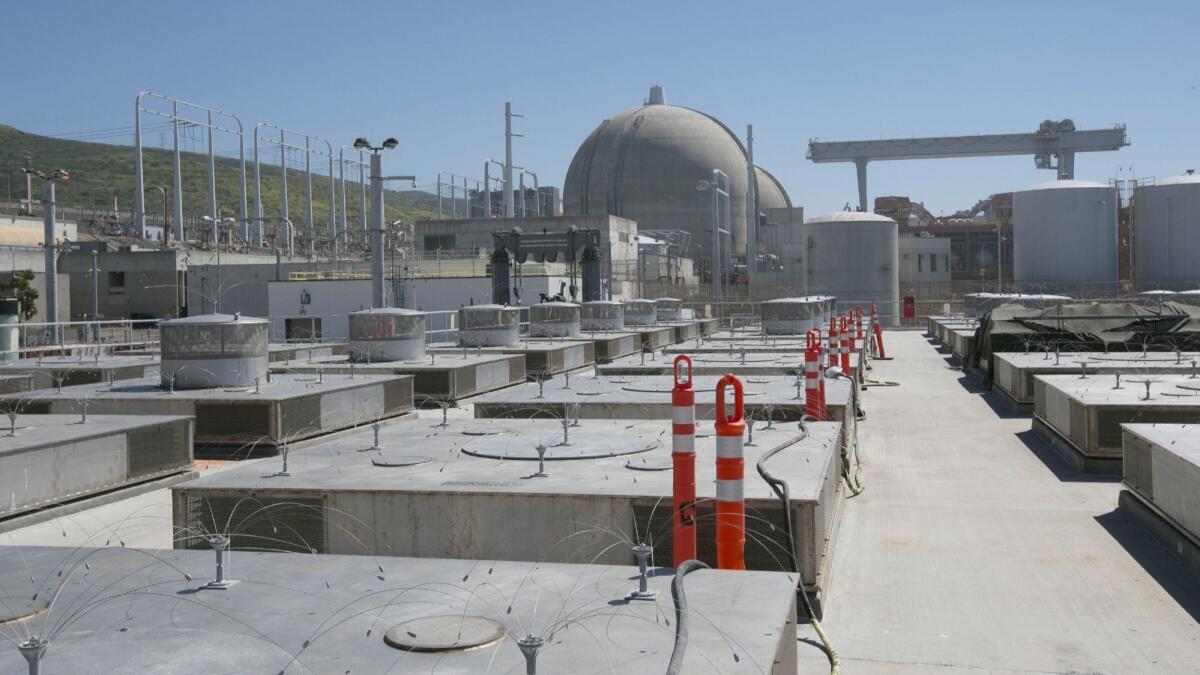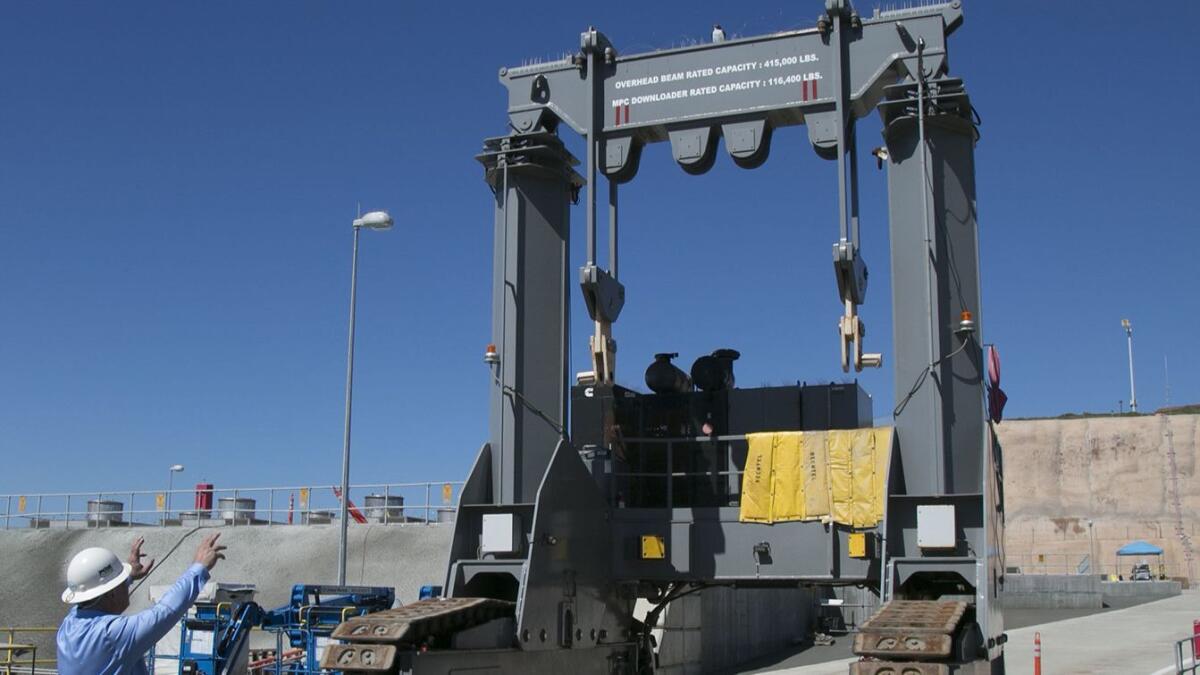Edison vows no repeat of nuclear canister incident at San Onofre

Southern California Edison has unveiled safety improvements at the San Onofre Nuclear Generating Station concerning the movement of heavy canisters filled with spent nuclear fuel from one area of the plant to another, about seven months after a 50-ton canister of nuclear waste was accidentally left suspended about 18 feet from the floor of a storage cavity for about 45 minutes.
Next week, the U.S. Nuclear Regulatory Commission is expected to issue a “final enforcement decision” regarding the incident. The NRC’s decision may include civil penalties.
“Nuclear safety is a core value for this company,” said Ron Pontes, manager of the plant’s decommissioning environmental strategy, during a media tour of the San Onofre plant Monday. “And I think that we probably, to be quite candid, we lost sight of that a little bit in this process and we didn’t demand that rigor out of our contractors. We’re going to demand it now.”
Edison, which is in charge of oversight at the facility, had contracted with New Jersey-based Holtec International to transfer the canisters on a roughly 1,500-foot trip from “wet storage” pools to a newly constructed “dry storage” facility at the plant, where they are then lowered into vaulted cavities a little more than 100 feet from the ocean.
The tour included a 90-minute briefing with Edison representatives spelling out what they said are changes in supervision and work culture to make sure the Aug. 3 incident doesn’t happen again.
Jim Peattie, general manager of decommissioning oversight at the plant, said Edison has beefed up training, added equipment, improved procedures and put in place a revamped “corrective action plan” to more effectively identify problems and fix them.
“We’re going to have extra oversight people,” Peattie said.
First revealed to the public by a worker at the plant, the August incident occurred when workers thought the canister had been completely lowered into the storage vault, but it had not. Instead, it came to rest on an inner ring near the top of the cavity, 17 to 18 feet from its floor.

What’s more, the heavy canister was not supported by the rigging and lifting equipment that includes two slings designed to complete the transfer operation.
Within a few minutes, the mistake was noticed and the canister was eventually lowered, but not before it was left unsupported for about 45 minutes.
Edison and Holtec have said workers and the public were not in danger and even if the canister had fallen 18 feet, the “robust” design of the canister would have prevented any radioactive release.
But since the incident, Edison has suspended all transfers at the plant, and the NRC in September launched a weeklong “special inspection” into what happened.
A report from the inspection criticized Edison for violations that may require “escalated enforcement action,” with the agency saying it “is concerned about apparent weaknesses in management oversight” regarding the transfers.
Among the findings, the NRC inspectors said the Aug. 3 incident marked the first time the crane operator of the transporter that moves the heavy canisters had actually completed a downloading operation. It was also the first time the “rigger/spotter” — who watches the top of the canister to make sure it is successfully lowered — had attempted to perform the downloading.
Edison officials now say 11 workers or oversight personnel will be required when canisters are transferred, compared to nine in August. A camera has also been mounted near the top of the heavy equipment that lifts the canister and moves it into the appropriate storage cavity.
“There’s a camera system set up where you can actually watch the canister download,” Peattie said. An alarm system also has been installed to help make sure a loaded canister is not left unsupported.
Overall, Edison will work much more closely with Holtec during all transfers.
Edison officials have said they will not resume transfers until the NRC has completed its inspection work and the company is satisfied that new training and improvements have been “successfully demonstrated.” But Peattie said if the NRC on Monday allows Edison to resume transfers, the process can resume within days.
“We don’t know what the NRC is going to say that day,” Pontes said. “I don’t want you to think that we have some expectation they will say, ‘You’re approved to go,’ because we just don’t know if they’re satisfied with everything.”
The canister lowered on Aug. 3 marked the 29th of 73 canisters moved to the new dry storage facility. Forty-four others are scheduled to eventually be transferred.
Edwin Lyman, acting director of the Nuclear Safety Project for the Union of Concerned Scientists, said the shored-up measures appear positive but Holtec and Edison need to make sure no other problems follow.
“Let’s face it, this is not brain surgery,” Lyman said. “It’s just moving a heavy object from one place to another and putting it into a hole.… It’s relatively simple but as you can see even relatively simple operations require great rigor to do them properly because nuclear technology is very exacting. This incident was an eye-opener and hopefully it has shocked Edison and Holtec out of whatever complacency led to this event” on Aug. 3.
One of the Edison’s critics, Gary Headrick, co-founder of the advocacy group San Clemente Green, said the enhanced safety effort “seems to make sense” but he worried about longer-term issues, such as the strength and security of the canisters.
“We’re putting a lot of faith in an industry that has let us down in so many other ways that it’s not building much confidence,” he said.
Edison officials insist the stainless steel canisters are safe and the dry storage facility designed by Holtec works well.
Monday’s tour comes just days after San Diego attorney Michael Aguirre filed a federal lawsuit against the NRC, complaining the federal agency “has engaged in stonewall tactics” in turning over Freedom of Information Act requests for documents related to problems during the transfer process at the San Onofre facility.
NRC officials have said they do not comment on pending litigation.
San Onofre has not produced electricity since the plant shut down following a leak in a steam generator tube in 2012. The following year the plant officially closed. It is now in the process of being decommissioned.
rob.nikolewski@sduniontribune.com
More to Read
Inside the business of entertainment
The Wide Shot brings you news, analysis and insights on everything from streaming wars to production — and what it all means for the future.
You may occasionally receive promotional content from the Los Angeles Times.











